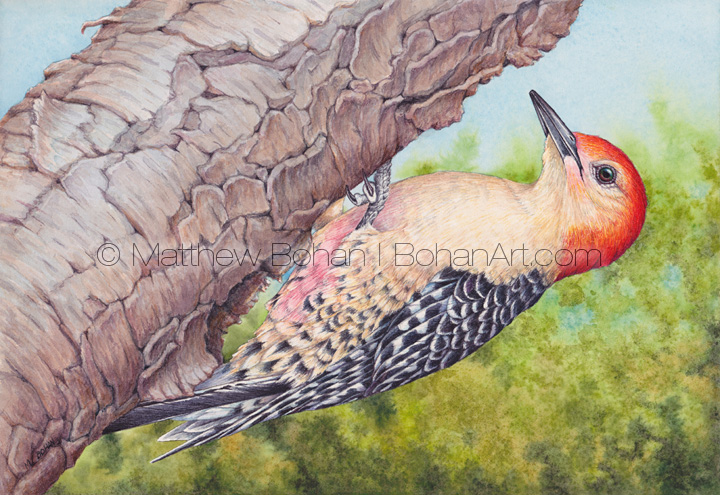

It’s taken me a while to post this painting, my first of 2017. Don’t worry, I’ve been hard at work and very productive, but posting completed projects has been neglected. This Red-bellied Woodpecker was fun to paint. Using a 400mm lens I took photos of a cooperative female in the backyard, but I decided to change it up and paint a more colorful male. I always love the opportunity to paint red feathers, so the temptation of rendering a male won out. In my photo reference you could actually see some of the “red” belly, but this guy, like most, is definitely more “pink bellied.” The naming of these birds could use a little improvement.
Many birds, like this guy, have names that are misleading for a bird watcher. In the field you can almost never see the red belly. It’s usually snugged up against the tree. Years ago while in grad school for medical illustration, I had a work-study job in the Bird Division of the Museum of Zoology at the University of Michigan. I prepared study skins for their collections. I learned a lot. The staff were incredibly nice, and it was interesting work. My time there shed light on the confusing names that some birds, like the Red-bellied Woodpecker, are saddled with. When you see the study skins in the collection drawers, they all are positioned on their backs with the belly pointing up. In the specimen drawer that red belly is the first thing you notice. Suddenly that name made more sense, as well as some of the others that featured rump and belly colors, like Black-bellied Plovers and Crimson-rumped Toucanets. Of course that doesn’t make the name any more useful in the field.
During this time I was also taking gross anatomy at the medical school a few blocks away. This made for an interesting comparison. Dissecting a 150+ pound cadaver was a lot different than the several-ounce American Goldfinch. Some skills were transferrable. I remember one of the med students being amazed at how easily I could trace out the tiny nerve bundles. I recall saying, “Compared to dissecting a goldfinch, this is a breeze!”
The smells in the cadaver lab were always WAY worse than anything in the bird division. Formaldehyde, formalyn or whatever witches-brew of weapons-grade hazmat chems they used there was uber-nasty. The bird division, on the other hand, usually didn’t have a very objectionable smell. Occasionally, you’d do an olfactory double-take when entering the skinning area; it would reek of skunk. That scent is definitely out of place in a museum. It invariably meant a Great Horned Owl was being processed. Skunks don’t have many natural predators, but the Great Horned Owl has a taste for the stinkers. Lacking a sense of smell comes in handy for these owls.
The only other time it tended to get stinky in the bird division was when we did oiled birds. After the Exxon Valdez oil spill, truckloads of dead, oiled birds were bagged and frozen as evidence. After a period time they were no longer needed for the court case, so the federal government offered up the birds to universities and institutions for study. UM sent their wish list to the feds and then had a freezer-full of bagged, oily carcasses to process. Honestly, it was pretty hard to tell what was in some of the bags. A Bald Eagle bag was pretty obvious, but determining whether a black, oily glob was a Murrelet or an Auklet was all but impossible for me.
After being measured, the Exxon birds that were badly decaying were skeletonized by dermestid beetles. It must have tasted fine to them, because everything but the bones disappeared, but really, I suppose their standards are just exceptionally low. The birds that were in better condition were cleaned up and processed like any other bird, except that the cleanup took WAY longer. This gave me a real admiration for the cleaning power of Dawn dish detergent. Though it took a while, Dawn was actually able to muscle through that thick, stinky glop. I couldn’t imagine a living bird having to go through that. In the end, though, the specimens were beautiful and even smelled clean! There were also some surprises. As we were cleaning the birds, we’d frequently have to call someone from the Entomology Department. They’d be awfully excited when we’d find an occasional parasite attached to a bird.
My artistic skills occasionally came in handy in the Bird Division, particularly pen and ink. When a study skeleton is prepared, every bone has to have the museum’s super-long collection number written on it. Think about it: even something as big as a goose has some small bones. Now imagine writing that same number on the tibiotarsus of a Winter Wren. OK, some of the tiniest bones were put in glass vials with the number written on a slip of paper, but for accuracy you always wanted to physically write the number if it was at all possible. My manual dexterity for detail is the same now, but my vision was much better back then!
Working at the Bird Division of the Zoology Museum may sound challenging and a bit on the gruesome side at times, but it was incredibly interesting and a great place to learn about birds. I’m hardly a bird expert, but having that hands-on experience helped with knowing the anatomy when drawing and painting birds. It would be hard to get that any other way.


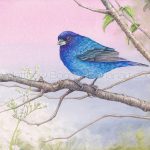

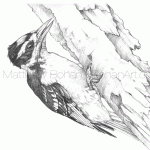
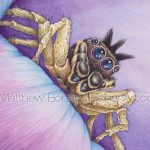
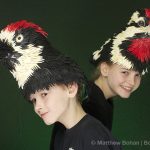
Heather Lester
Hi there, Beautiful art. Thank you for sharing your art and story.
How I came to find your blog is because I have been having a Red Bellied Woodpecker visiting my bird feeder in my garden. I went looking for videos on YT And found your painting video Which also has the link to this blog here.
I really enjoyed reading this blog entry.
And you have just about answered my question as I was wondering why the red Bellied Woodpecker has that name when the belly is rarely visible to us and the colour is more pink than red.
Your time in the museum sounds like it was fascinating and very educational.
I too wonder why some birds have the name they’re given because the names often do not seem to match up With the bird’s most obvious markings and characteristics. But I’m sure there is a legitimate reason as to why that most of us would not realize and are aware of.
I was also thinking that maybe because there’s already a bird named the
Red-Headed Woodpecker they had to come up with an alternate name. 😁
Maybe it could have been named the Red Capped Woodpecker Or
Zebra Back Woodpecker.
Oh well, I love birds and I enjoy watching them and I love artwork with birds. And your work is wonderful.
I am an amateur artist and do a little drawing and painting myself and will have a go at a Woodpecker sometime.
Take care.
Matt
Thanks for the comments! You are so right. The common names are at times almost arbitrary. The Red-headed Woodpeckers have that completely red head, as opposed to the cap and nape, so I suppose they should have dibs on the name. The scientists have a good reason to stick with the Latin names with all the confusion. Definitely find some time to paint a few woodpeckers!
Matt